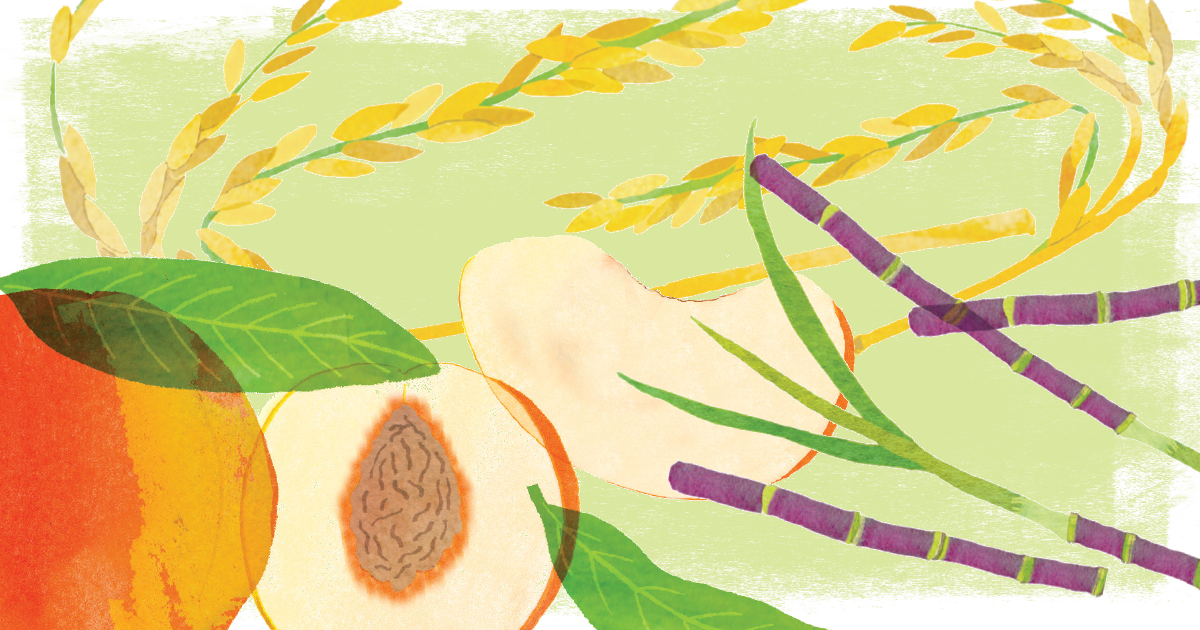by Robin Mosley, Communications and Development Coordinator
Illustrations by Claudia Pearson

Throughout the nation, there will be several parts of Black history that we’ll celebrate as a tribute to people and cultures that influenced the world. As a Black American, there is much to be proud of, including food. I have a lot of pride when it comes to Black cuisine because our cuisine is as diverse as the cities we reside in. For example, there is no one mac and cheese recipe that is the same as any other, but there is an expectation that it’s traditional, often the way our grandmothers made it, so no testing recipes around the holiday. But, it’s always nice to see Black people online and in person showing pride in family recipes.
For many generations, Black people have cultivated land here in the US. We’ve been integral to the economy through slavery, sharecropping and farming. At each of these points in history, we’ve also transformed unwanted crops, cheap cuts of meat and more into historical tapestries that can fit on a spoon.
Working the land is closer to many Black people’s present day stories than we think. As a lifelong Chicagoan, I have close ties to farming. Years ago, doing a family search online led me down a rabbit hole that revealed my own great-grandparents were farmers in Mississippi. What I didn’t realize until much later is how their connection to farming influenced my grandmother, who had her own garden. At a given time, I saw her grow tomatoes, lettuce and cabbage that she would bring in and cook. I ate a lot of fried green tomatoes around her, and that experience gave me a lot of pride growing up, but also showed me that you can eat what you grow. Just like history, food can fade away into obscurity or be appropriated if we don’t take care of it, so preserving food that holds historical value is important.
This Black History Month, Slow Food USA is celebrating the historic and present-day value of three Ark of Taste crops that are farmed today, have significance for Black communities and promote our mission of good, clean and fair food.
Carolina Gold Rice
Some people consider Carolina Gold a “golden crop.” While we know a lot about cotton plantations in the American South, Gullah Geechee people tended to rice in plantations, too. The Gullah Geechee are descendents of Africans who were on “rice, indigo and Sea Island cotton plantations,” from the West African countries known for growing rice. Today, the Gullah Geechee people work hard to preserve their unique cultural heritage, including their foodways like Carolina Gold rice. This rice is essential to Lowcountry cuisine and is worth its weight in gold because it ties history and food together. Across the south, Carolina Gold made its way into meals such as jambalaya and chicken bog. While it’s not the first rice grown in South Carolina (that title goes to Madagascar White), it is the perfect vessel to carry flavors and is highly sought after commercially. Carolina Plantation Rice, Marsh Hen Mill and Anson Mills produce this rice.
Belle of Georgia Peach
Who doesn’t love a good peach? In the South and northern cities across the United States, Black Americans use peaches for dishes near and dear to history, including peach cobbler. Peaches are certainly an important part of U.S. cultural history, and this one sprung up around 1870, five years after the end of slavery. When cotton fell, peaches became a huge commodity crop, and the sudden availability of labor needed by freed Black people helped redefine agriculture. What makes the Belle of Georgia different from other peaches is that it’s a white flesh peach. Its delicate flavor works well with a number of desserts and drinks. Nowadays, this peach isn’t commonly grown in Georgia and South Carolina; you’ll find it cultivated in California. Places such as Willis Orchards, Ty Ty Nursery and Trees of Antiquity grow Belle of Georgia peaches.
Purple Ribbon Sugarcane
Sugarcane is another crop that has a history connected to slavery. While there is quite a bit of history around sugarcane and the labor needed to make those crops successful, there has been an important movement to revitalize Purple Ribbon sugarcane through the Gullah Geechee people of Sapelo Island. The introduction of this sugarcane also created new jams, wines and more in the U.S. While many of us are used to seeing green sugarcane, Purple Ribbon is a variety that was nearly wiped out. However, farmers, historians and geneticists created a disease-resistant version. For Sapelo Island, this crop was important to the land and autonomy after slavery. Even though commercial companies came in to capitalize on this sugarcane, to this day, Sapelo Island natives have expanded Purple Ribbon sugarcane on the island through liberation farming by the way of Sapelo Island Cultural and Revitalization Society (SICARS), which honors traditions and reclaims power. Currently, Georgia Coastal Gourmet Farms produces this sugarcane.
What I’ve learned about food through my family traditions is that food can change over time. What your grandparents made might be different from your parents and it can be different from what you make, even if it’s the same dish. But what remains through food is the history that you tell every time you eat.
Food is a symbol of culture and resiliency, from the legacy of farming passed down to the celebration of many culinary traditions that are enjoyed across the United States. If you’re interested in learning more about the Ark of Taste, check it out here.

